Geochemistry of Weathering Cover and the Main Influencing Factors in Karst Area of Guilin, Southwest China
Abstract
1. Introduction
2. Materials and Methods
2.1. Study Area
2.2. Sampling and Testing
3. Results and Discussion
3.1. Chemical Composition and Distribution Characteristics of Guilin Weathering Cover
3.2. Normalization against Average UCC for the Elements in GUILIN Karst Weathering Cover and the Comparation with Other Karst Area
3.3. Chemical Weathering Intensity
3.3.1. CIA Index
3.3.2. Na/K, K/Al Ratio
3.3.3. A-CN-K Diagram
3.4. Factors Affecting Chemical Weathering
- (1)
- Parent rock
- (2)
- Terrain
- (3)
- Climate
4. Conclusions
- Karst weathering covers in Guilin have the similar geochemical characteristics with the weathering covers in other karst areas of China. First, their chemical composition is similar; second, their chemical composition is evenly distributed on the profile; third, compared with UCC, their Na, K, Ca and Mg show obvious loss, while the Fe, Al and trace\heavy metal elements show obvious enrichment. Trace elements are more enriched in Guilin weathering cover than red soil and loess. The rapid dissolution of Ca and Mg in the weathering process has an important impact on the migration and enrichment of elements.
- The CIA of Guilin weathering cover and other carbonate weathering covers are much larger than that of the upper continental crust (UCC) (60.13), showing strong chemical weathering characteristics in humid and hot climate environments. The average chemical index of alteration (CIA) of Guilin karst weathering covers is 91.48, which is equivalent to that of carbonate weathering covers in Xingyi, Guizhou, and Kunming, Yunnan, and higher than that in central Yunnan, and Northern Guizhou, Qinghai-Tibet Plateau and Northern China.
- Different from the weathering trend of silicate and loess, the soluble components (calcite and dolomite) of carbonate weathering covers in China rapidly and completely dissolved and leached in the early stage of weathering. These covers are in the stage of potassium leaching, iron and aluminum enrichment. Therefore, the CIA does not correlate with Na/K (molar ratio), but significantly negative correlate with K/Al (molar ratio).
- The analysis of influencing factors of CIA of carbonate weathering cover shows that the CIA of carbonate weathering covers in southern China, including Guilin karst weathering cover, is negatively correlated with latitude. In terms of lithology, the chemical composition of the parent rock has an impact on the CIA of the karst weathering cover, and the content of "insoluble matter" in carbonate rock is negatively correlated with CIA of weathering cover. Topographically, the CIA of carbonate weathering cover tends to decrease from high to low and from shallow to deep.
Author Contributions
Funding
Data Availability Statement
Acknowledgments
Conflicts of Interest
References
- Taylor, L.L.; Banwart, S.A.; Valdes, P.J.; Leake, J.R.; Beerling, D.J. Evaluating the effects of terrestrial ecosystems, climate and carbon dioxide on weathering over geological time: A global-scale process-based approach. Philos. Trans. R. Soc. Lond. 2012, 367, 565–582. [Google Scholar] [CrossRef]
- Liu, C. Biogeochemical Processes and Surface Material Circulation: Erosion and Biogenic Factor Circulation in Southwest Karst Basin; Science Press: Beijing, China, 2007. [Google Scholar]
- Kump, L.R.; Brantley, S.L.; Arthur, M.A. Chemical Weathering, Atmospheric CO2, and Climate. Annu. Rev. Earth Planet. Sci. 2000, 28, 611–667. [Google Scholar] [CrossRef]
- Zhang, S.R.; Bai, X.Y.; Zhao, C.W.; Tan, Q.; Luo, G.J.; Wang, J.F.; Li, Q.; Wu, L.H.; Chen, F.; Li, C.J.; et al. Global CO2 Consumption by Silicate Rock Chemical Weathering: Its Past and Future. Earths Future 2021, 9, e2020EF001938. [Google Scholar] [CrossRef]
- Mehta, P.; Malviya, V.P. Weathering pattern of amphibolites in the different climate zones from Western Dharwar Craton, Southern India. Arab. J. Geosci. 2021, 14, 2435. [Google Scholar] [CrossRef]
- Sandeep, K.; Shankar, R.; Warrier, A.K. A Late Holocene Record of Variations in the Chemical Weathering Intensity and Pedogenesis in a Lake Catchment from Southern India. Aquat. Geochem. 2022, 28, 27–42. [Google Scholar] [CrossRef]
- Ji, H.B.; Wang, S.J.; Ouyang, Z.Y.; Zhang, S.; Sun, C.X.; Liu, X.M.; Zhou, D.Q. Geochemistry of red residua underlying dolomites in karst terrains of Yunnan-Guizhou Plateau: I. The formation of the Pingba profile. Chem. Geol. 2004, 203, 1–27. [Google Scholar] [CrossRef]
- Zhang, M.; Yao, Y.; Qiu, Z.; Mao, X.; Yang, L. Pedogenetic characteristics and taxonomic classification of soils developed from carbonate rocksin the south of China. J. Zhejiang Univ. Agric. Life Sci. 2019, 45, 54–65. (In Chinese) [Google Scholar]
- Zhou, D.; Wang, S.; Liu, X. Study on geochemical processes in limestone soil profiles. Geol. Geochem. 2005, 33, 31–38. (In Chinese) [Google Scholar]
- Liu, X.M.; Wang, S.J.; Feng, Z.G.; Sun, C.X. Identification of origin of limestone soil-case study of profiles in central and north Guizhou. Soil 2004, 36, 30–36. (In Chinese) [Google Scholar]
- Wang, S.J.; Liu, X.M.; Zhang, F. Fission track dating of secondary quartz in red weathering crusts of carbonate rocks in Guizhou Province. Geochimica 2005, 34, 33–40. (In Chinese) [Google Scholar]
- Wang, S.J.; Ji, H.B.; Ouyang, Z.Y.; Zhou, D.Q.; Zheng, L.P.; Li, T.Y. Preliminary Study on weathering and pedogenesis of carbonate rock. Sci. China Ser. D Earth Sci. 1999, 42, 14–23. [Google Scholar] [CrossRef]
- Feng, J.L.; Zhu, L.P.; Cui, Z.J. Quartz features constrain the origin of terra rossa over dolomite on the Yunnan-Guizhou Plateau, China. J. Asian Earth Sci. 2009, 36, 156–167. [Google Scholar] [CrossRef]
- Liu, W.J.; Liu, C.Q.; Zhao, Z.Q.; Xu, Z.F.; Liang, C.S.; Li, L.B.; Feng, J.Y. Elemental and strontium isotopic geochemistry of the soil profiles developed on limestone and sandstone in karstic terrain on Yunnan-Guizhou Plateau, China: Implications for chemical weathering and parent materials. J. Asian Earth Sci. 2013, 67–68, 138–152. [Google Scholar] [CrossRef]
- Wei, X.; Ji, H.B.; Li, D.J.; Zhang, F.L.; Wang, S.J. Material source analysis and element geochemical research about two types of representative bauxite deposits and terra Rossa in western Guangxi, southern China. J. Geochem. Explor. 2013, 133, 68–87. [Google Scholar] [CrossRef]
- Gong, Q.J.; Zhang, G.X.; Zhang, J.; Jiang, B.; Ma, N. Behavior of REE fractionation during weathering of dolomite regolith profile in southwest China. Acta Geol. Sin. 2010, 84, 1439–1447. [Google Scholar]
- Beckford, H.O.; Chu, H.S.; Song, C.S.; Chang, C.; Ji, H.B. Geochemical characteristics and behaviour of elements during weathering and pedogenesis over karst area in Yunnan–Guizhou Plateau, southwestern China. Environ. Earth Sci. 2021, 80, 59–79. [Google Scholar] [CrossRef]
- Feng, Z.G.; Liu, X.Z.; Han, S.L.; Ma, Q. Study on geochemical behavior of high field strength elements during weathering of carbonate rocks: Evidence from leaching experiment on carbonate rock. Carsologica Sin. 2018, 37, 315–329. (In Chinese) [Google Scholar]
- Jia, Z.Y.; Wang, J.X.; Zhou, X.D.; Zhou, Y.J.; Li, Y.; Li, B.J.; Zhou, S.L. Identification of the sources and influencing factors of potentially toxic elements accumulation in the soil from a typical karst region in Guangxi, Southwest China. Environ. Pollut. 2020, 256, 113505.1–113505.9. [Google Scholar] [CrossRef]
- Xia, J.C.; Wang, J.X.; Zhang, L.M.; Wang, X.; Yuan, W.; Zhang, H.; Peng, T.; Feng, X.B. Mass Balance of Nine Trace Elements in Two Karst Catchments in Southwest China. Sci. Total Environ. 2021, 786, 147504. [Google Scholar] [CrossRef]
- Zhu, G.X.; Xiao, H.Y.; Guo, Q.J.; Song, B.; Zheng, G.D.; Zhang, Z.Y. Heavy metal contents and enrichment characteristics of dominant plants in wasteland of the downstream of a lead-zinc mining area in Guangxi, Southwest China. Ecotoxicol. Environ. Saf. 2018, 151, 266–271. [Google Scholar] [CrossRef]
- Wen, Y.; Li, W.; Yang, Z.F.; Zhuo, X.X.; Guan, D.X.; Song, Y.X.; Guo, C.; Ji, J.F. Evaluation of various approaches to predict cadmium bioavailability to rice grown in soils with high geochemical background in the karst region, Southwestern China. Environ. Pollut. 2020, 258, 113645. [Google Scholar] [CrossRef] [PubMed]
- Dong, R.; Jia, Z.; Li, S. Risk assessment and sources identification of soil heavy metals in a typical county of Chongqing Municipality, Southwest China. Process Saf. Environ. Prot. 2018, 113, 275–281. [Google Scholar] [CrossRef]
- Ji, H.B.; Ouyang, Z.Y.; Wang, S.J.; Zhou, D.Q. Element geochemistry of weathering profile of dolomitite and its implications for the average chemical composition of the upper-continental crust. Sci. China Ser. D Earth Sci. 2000, 42, 23–35. [Google Scholar] [CrossRef]
- Gong, Q.J.; Deng, J.; Jia, Y.J.; Tong, Y.K.; Liu, N.Q. Empirical equations to describe trace element behaviors due to rock weathering in China. J. Geochem. Explor. 2015, 152, 110–117. [Google Scholar] [CrossRef]
- Jiang, Z.C. Element migration of karst dynamic system. Acta Geogr. Sin. 1999, 54, 438–444. (In Chinese) [Google Scholar]
- Riebe, C.S.; Kirchner, J.W.; Finkel, R.C. Long-term rates of chemical weathering and physical erosion from cosmogenic nuclides and geochemical mass balance. Geochim. Cosmochim. Acta 2003, 67, 4411–4427. [Google Scholar] [CrossRef]
- Zhang, X.B.; Bai, X.Y.; He, X.B. Soil creeping in the weathering crust of carbonate rocks and underground soil losses in the karst mountain areas of southwest China. Carbonates Evaporites 2011, 26, 149–153. [Google Scholar] [CrossRef]
- Huang, F.; Wei, X.; Zhu, T.; Luo, Z.; Cao, J. Insights into Distribution of Soil Available Heavy Metals in Karst Area and Its Influencing Factors in Guilin, Southwest China. Forests 2021, 12, 609. [Google Scholar] [CrossRef]
- Zhang, K.; Ji, H.B.; Chu, H.S.; Song, C.S.; Wu, Y.F. Material Sources and Element Migration Characteristics of Red Weathering Crusts in Southwestern Guizhou. Earth Environ. 2018, 46, 257–266. (In Chinese) [Google Scholar]
- Cui, Z.J.; Hong, Y.; Gao, Q.Z. The process and environment of polaeokarst in the northeast area of Qinghai-Xizang Plateau. Acta Geogr. Sin. 1996, 28, 408–417+481. (In Chinese) [Google Scholar]
- Wang, S.J.; Sun, C.X.; Feng, Z.G.; Liu, X.M. Mineralogical and geochemical characteristics of the limestone weathering profile in Jishou, western Hunan Province, China. Acta Mineral. Sin. 2002, 22, 19–29. (In Chinese) [Google Scholar]
- Ji, H.B.; Ouyang, Z.Y.; Wang, S.J.; Zhou, D.Q. Element geochemical characteristics of dolomitic weathering profile and its significance to the average chemical composition of upper continental crust: A case study of Xinpu profile in northern Guizhou. Sci. China Ser. D 1999, 29, 504–513. (In Chinese) [Google Scholar]
- Jiang, W.; Li, Y.H.; Wei, D.L.; Shen, J.J. Preliminary geochemical characteristics of red weatherng crust in Shicao profile, southern Liaoning province. J. Arid. Land Resour. Environ. 2019, 33, 126–131. (In Chinese) [Google Scholar]
- Gao, Q.Z.; Cui, Z.J.; Tao, Z.; Liu, G.N.; Hong, Y. The Nature, Formation Age and Genetic Environment of the Palaeokarst on the Qinghai-Xizang Plateau. Acta Geogr. Sin. 2002, 57, 267–274. (In Chinese) [Google Scholar]
- Taylor, S.R.; Mclennan, S.M. The continental crust: Its composition and evolution. J. Geol. 1985, 94, 57–72. [Google Scholar]
- Taylor, S.R.; Mclennan, S.M.; Mcculloch, M.T. Geochemistry of loess, continental crustal composition and crustral model ages. Geochim. Cosmochim. Acta 1983, 47, 1897–1905. [Google Scholar] [CrossRef]
- Cao, W.J.; Ji, H.B.; Zhu, X.F.; Zhou, X.Y.; Qiao, M.M. Contrast of geochemical features of the typical weathered profiles in Guizhou Plateau. Carsologica Sin. 2012, 31, 131–138. (In Chinese) [Google Scholar]
- Huang, Q.B.; Qin, X.Q.; Liu, P.Y.; Tang, P.P. Analysis on tablets dissolution rate and carbon sink under different vegetation in north China karst area: A case study of Fenyang, Shanxi Province. Carsologica Sin. 2013, 32, 258–265. (In Chinese) [Google Scholar]
- Wu, H.Y.; Qin, X.M.; Jiang, Z.C.; Luo, W.Q.; Deng, Y. Effect of Karstification on Concentration of Zn2+ in Lime Soil Water at Huixian Guilin. Res. Agric. Mod. 2009, 6, 761–765. (In Chinese) [Google Scholar]
- Wu, H.Y.; Huang, C.H.; Li, T.F.; Huang, Q.B.; Luo, F. Characteristics of element migration and influencing factors of lime soil in Guilin, Guangxi: A case study of lime soil in Huixian peak-cluster valley. Carsologica Sin. 2021, 40, 835–848. (In Chinese) [Google Scholar]
- Chen, Y.; Chen, J.; Liu, L. Chemical composition and characterization of chemical weathering of late tertiary red clay in Xifeng, Gansu Province. J. Geomech. 2001, 7, 73–81. (In Chinese) [Google Scholar]
- Chen, J.; An, Z.S.; Liu, L.W.; Ji, J.F.; Yang, J.D.; Chen, Y. Variations in chemical compositions of the eolian dust in Chinese Loess Plateau over the past 2.5 Ma and chemical weathering in the Asian inland. Sci. China Ser. D 2001, 44, 403–413. [Google Scholar] [CrossRef]
- Li, X.; Han, Z.; Yang, D. REE Geochemistry of xiashu loess in Zhenjiang, Jiangsu Province. Acta Pedol. Sin. 2006, 43, 1–7. (In Chinese) [Google Scholar]
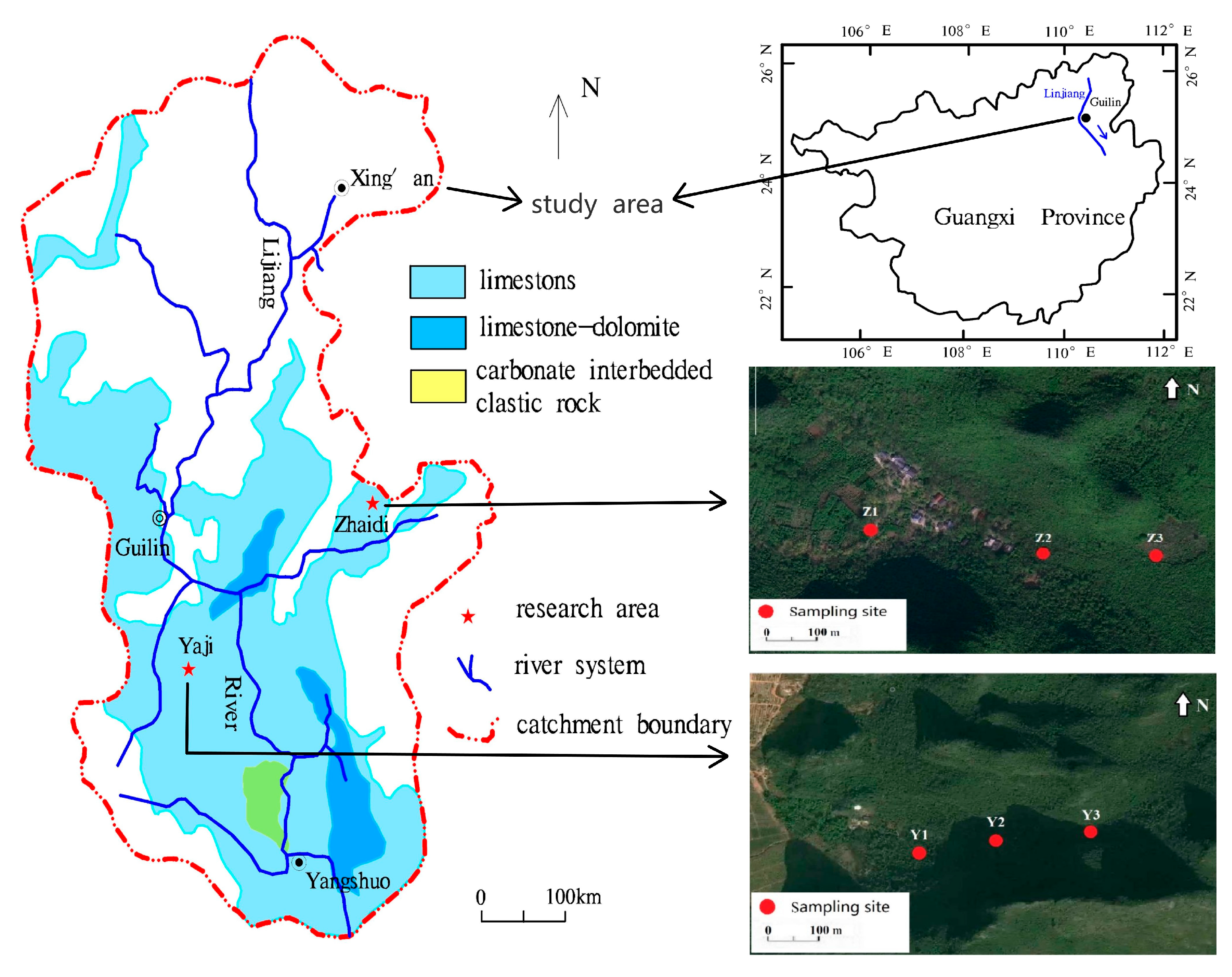


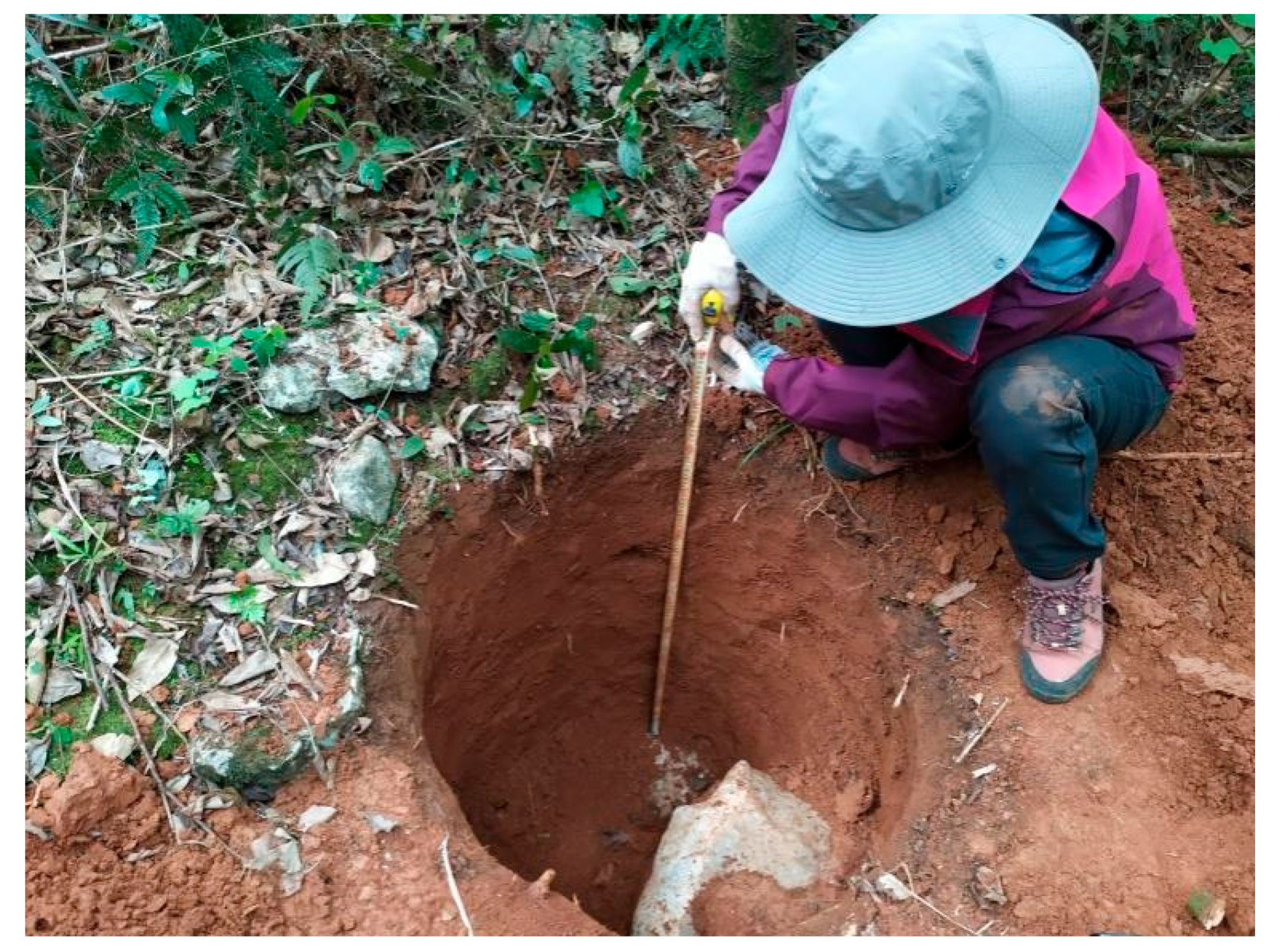
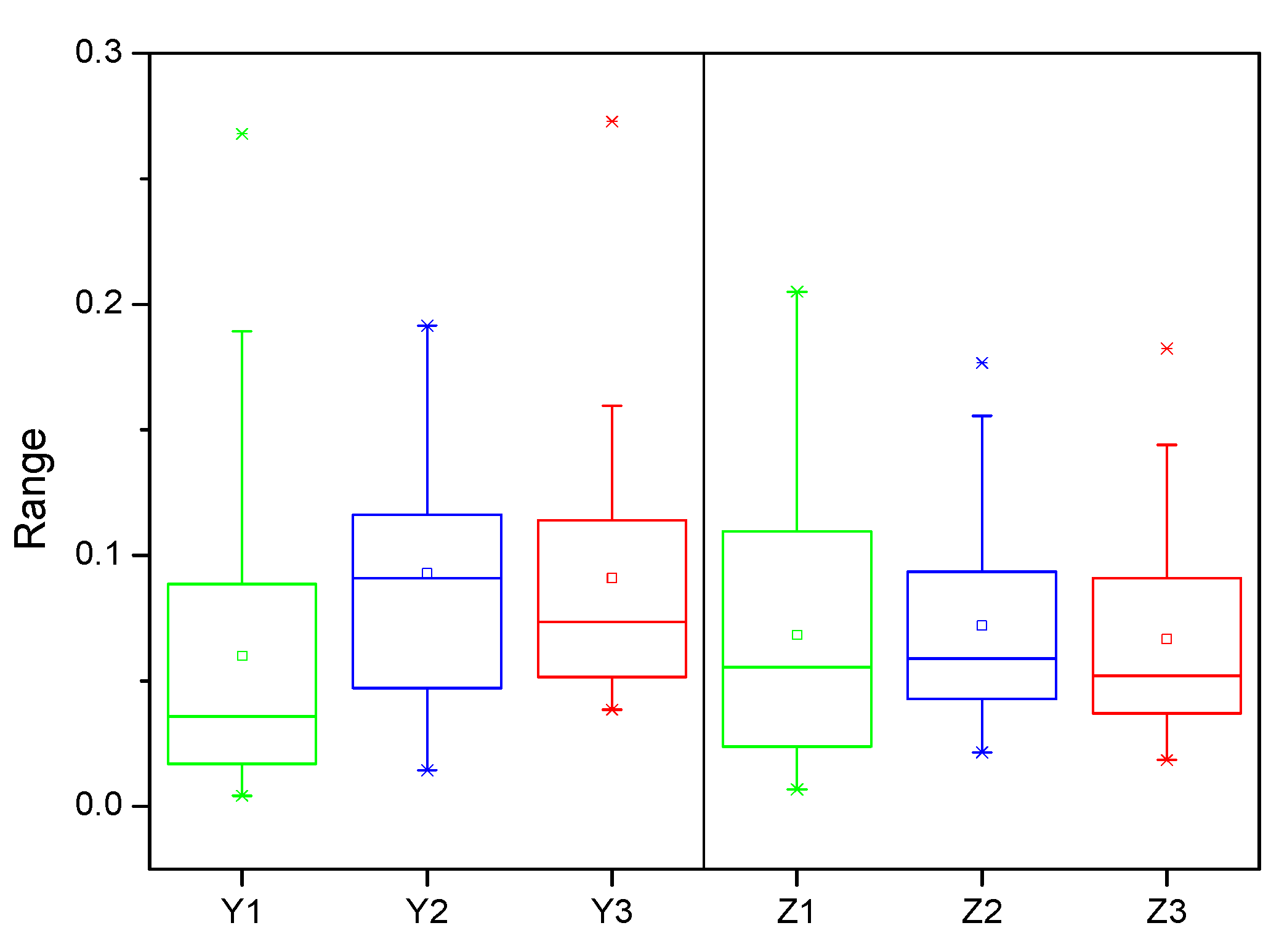
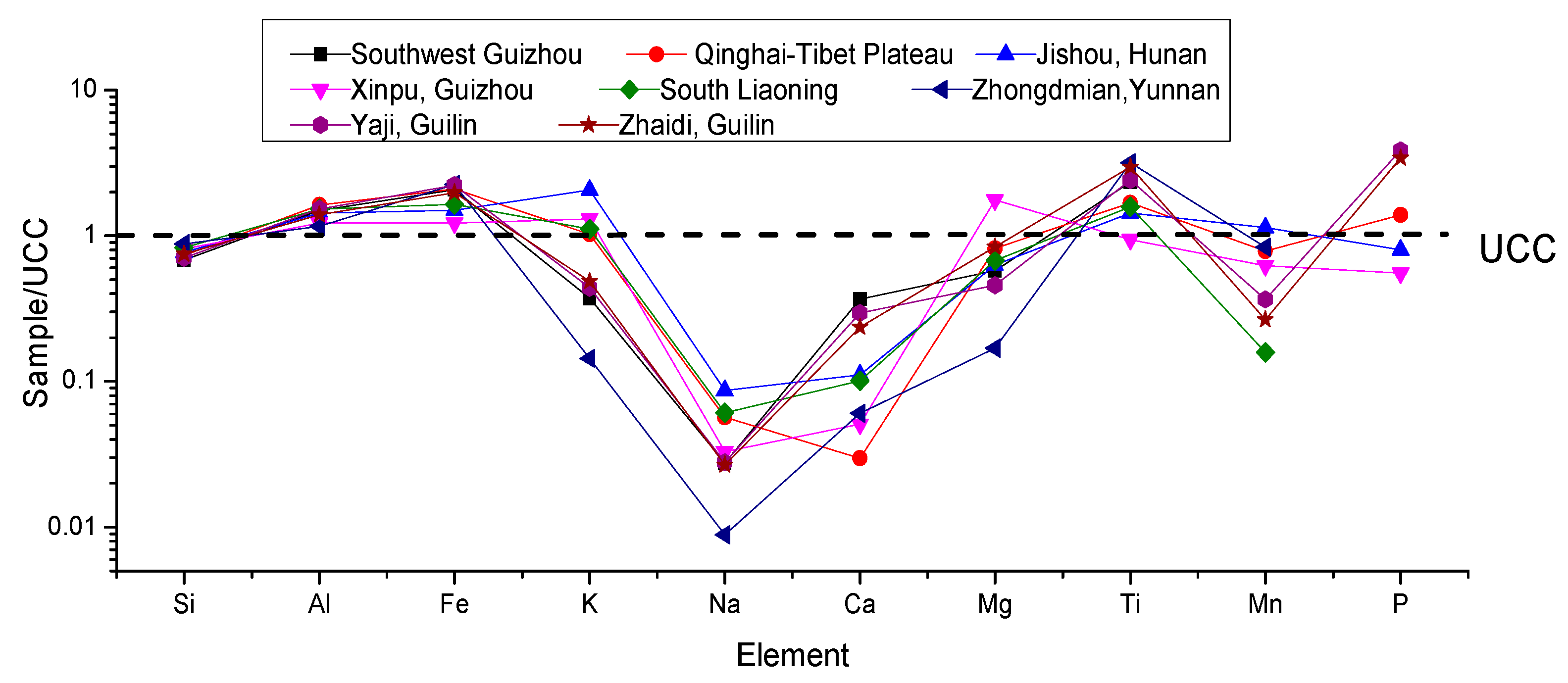
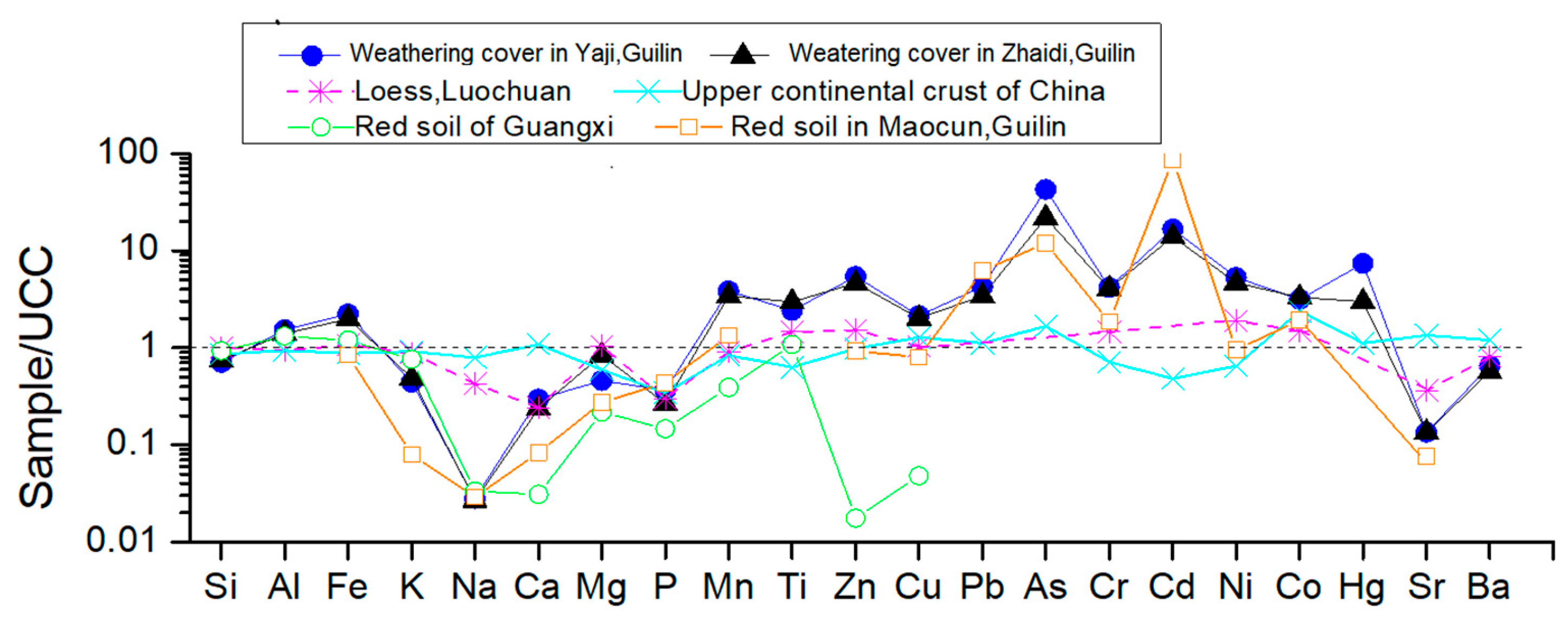
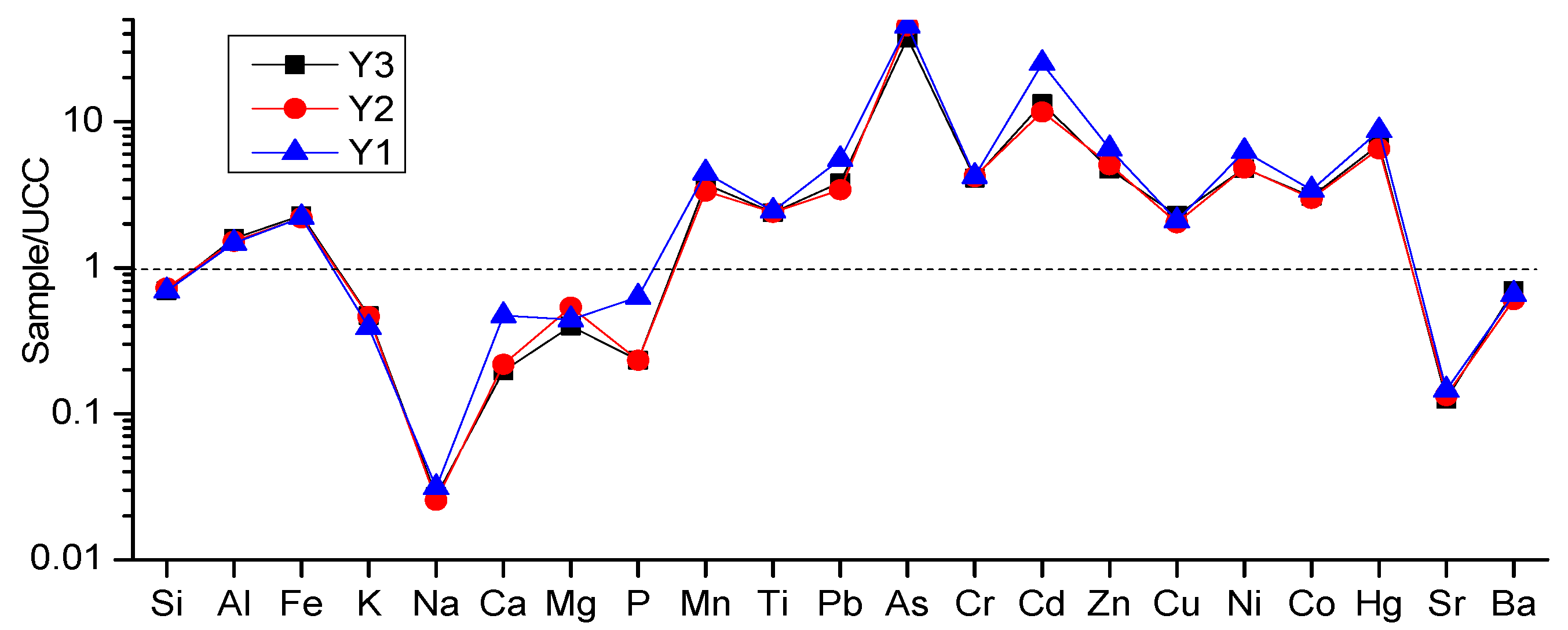
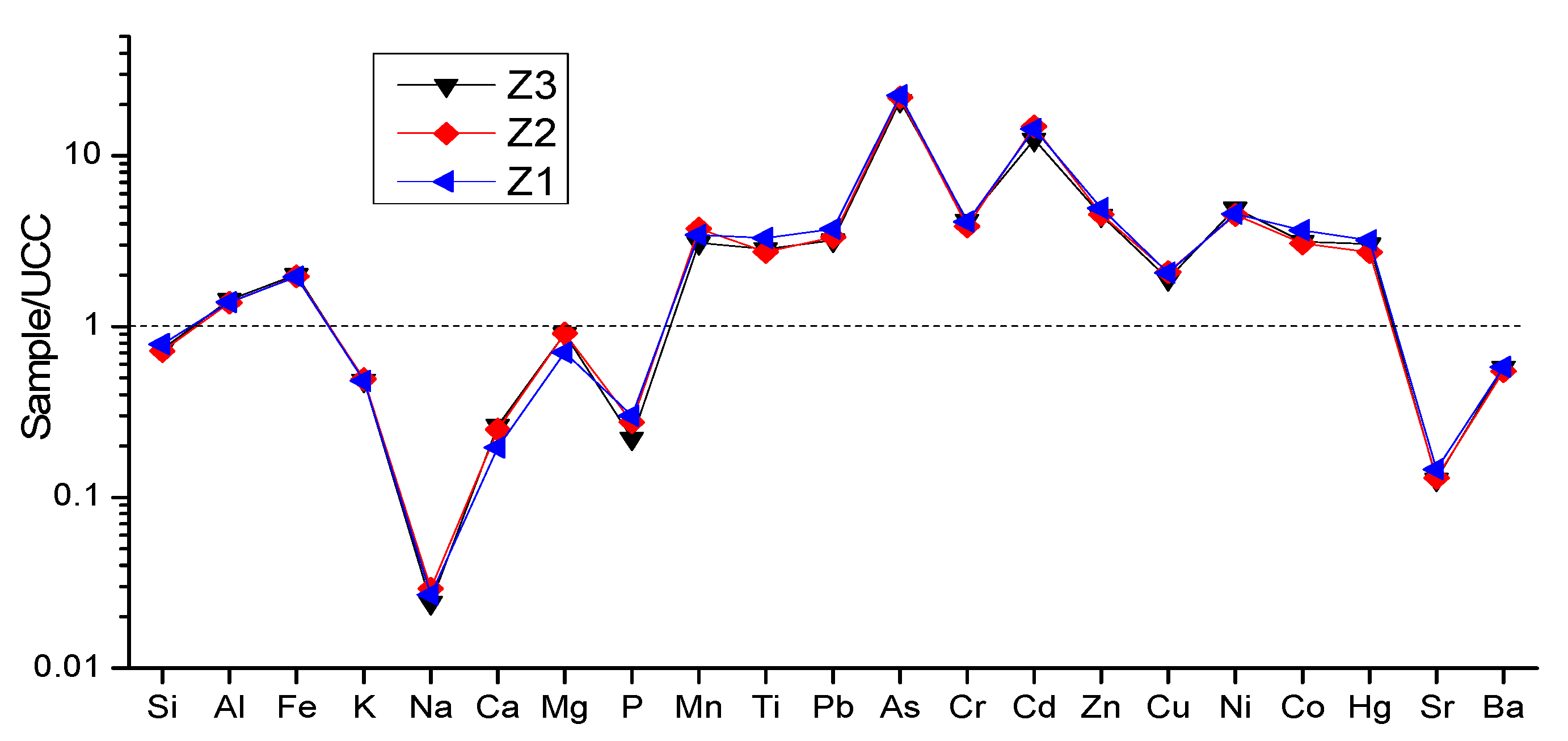

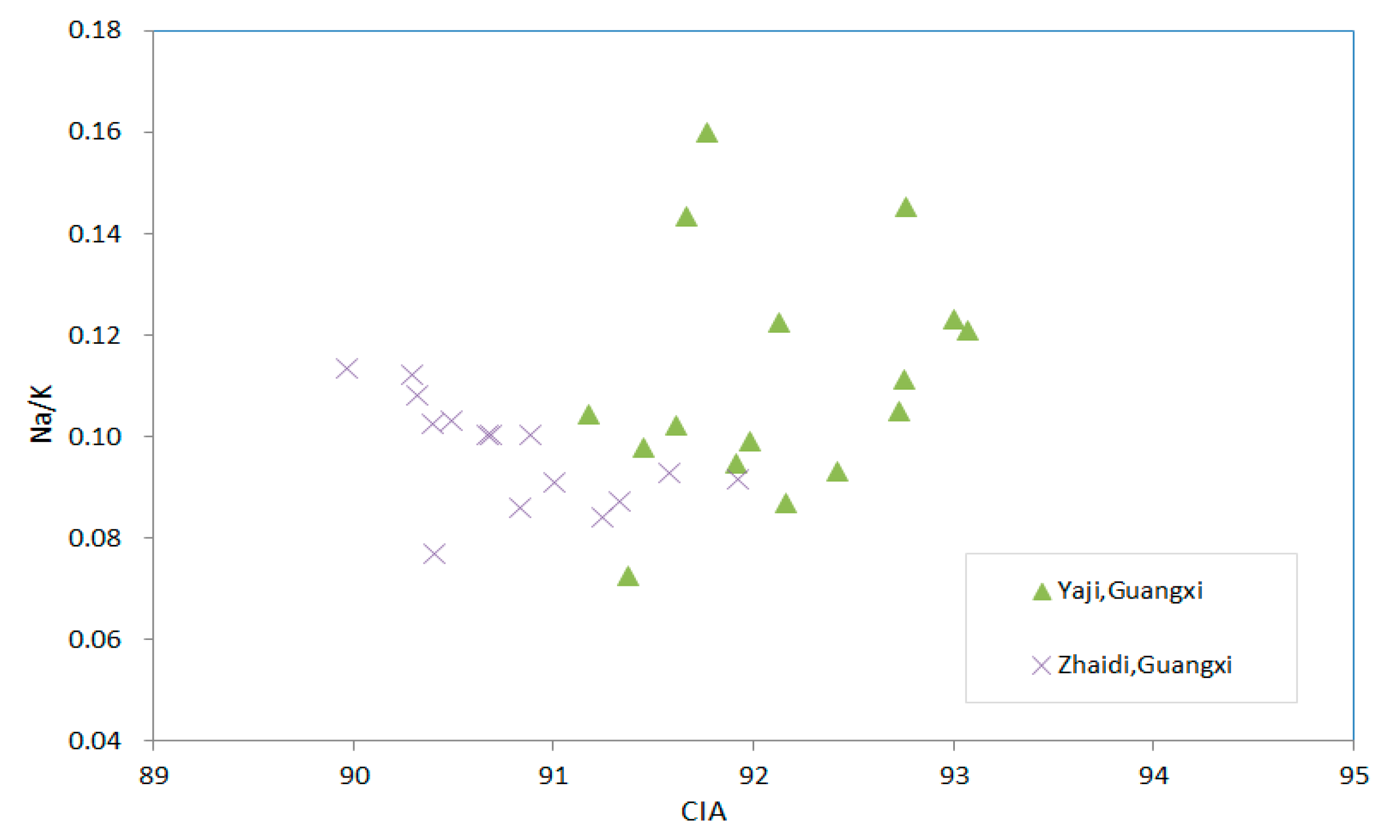

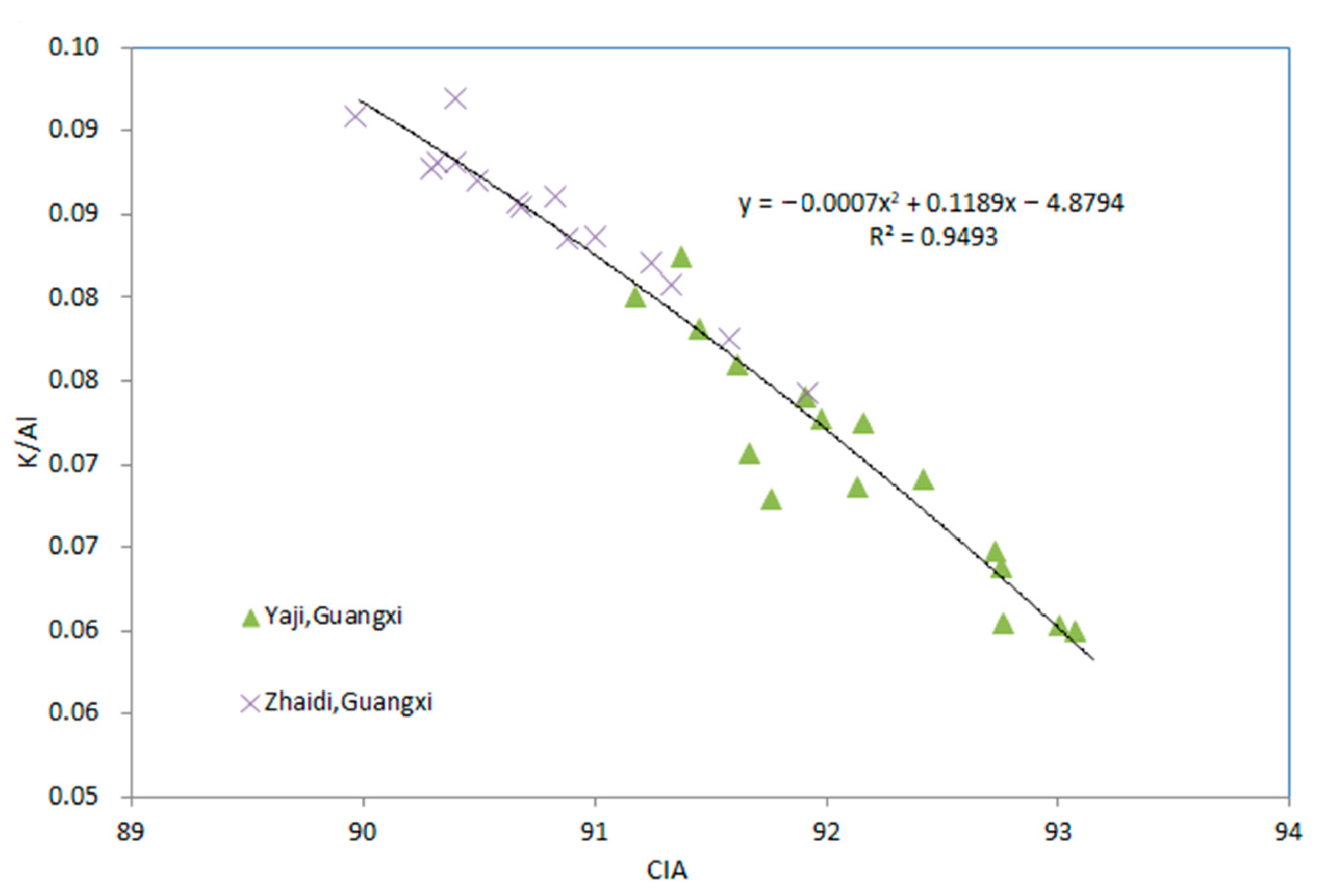

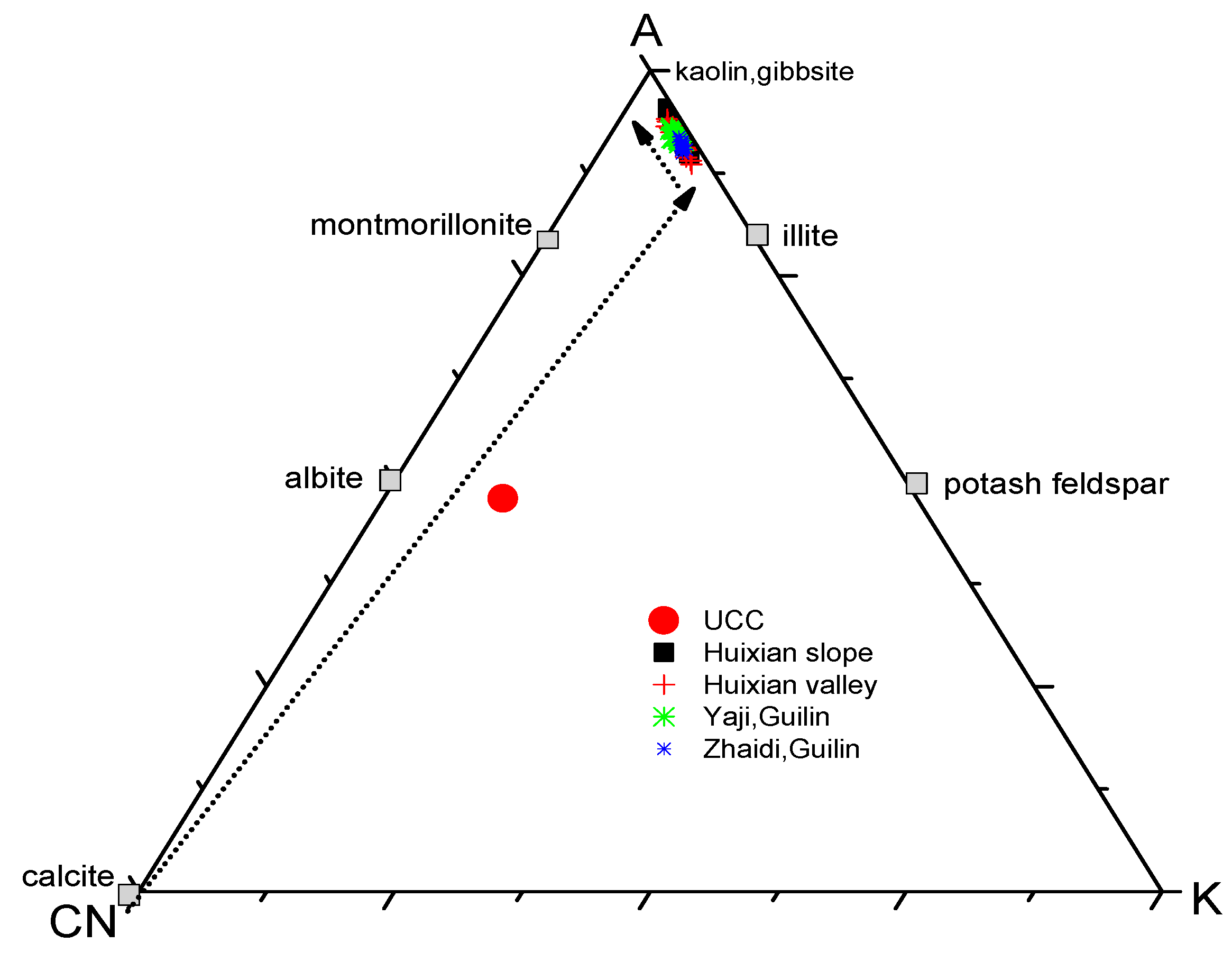
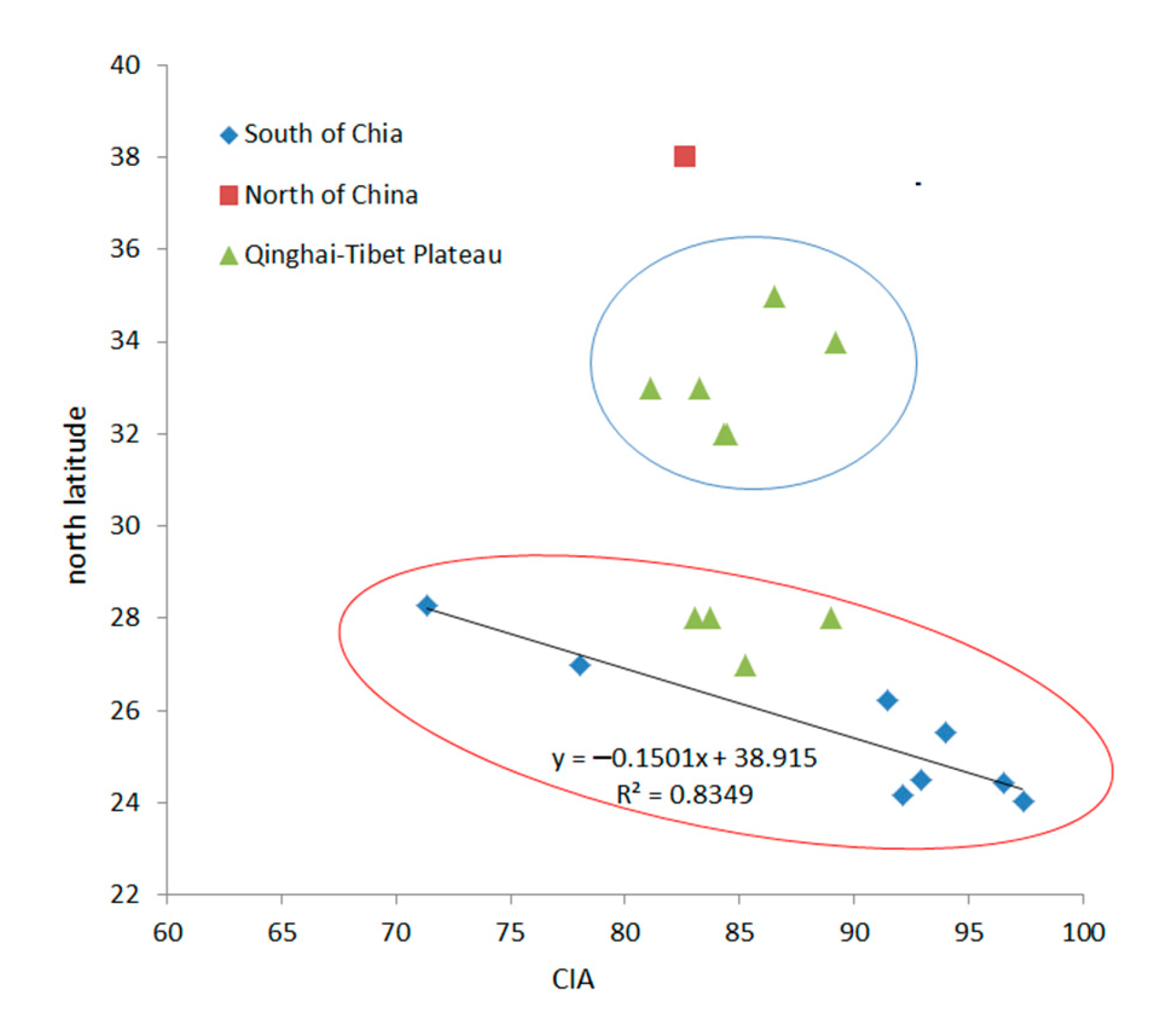
| Profile (Depth cm) | pH | SiO2 | Al2O3 | TFe2O3 | CaO | MgO | K2O | Na2O | TiO2 | P2O5 | MnO | CIA |
|---|---|---|---|---|---|---|---|---|---|---|---|---|
| % | % | % | % | % | % | % | % | % | % | |||
| Average value (Y3) | 6.36 | 46.05 | 24.10 | 10.26 | 0.83 | 0.88 | 1.60 | 0.11 | 1.19 | 0.12 | 0.29 | 92.05 |
| Average value (Y2) | 6.68 | 47.99 | 23.04 | 9.91 | 0.92 | 1.18 | 1.57 | 0.10 | 1.20 | 0.12 | 0.26 | 91.91 |
| Average value (Y1) | 7.32 | 45.90 | 22.47 | 9.95 | 1.98 | 0.97 | 1.32 | 0.12 | 1.23 | 0.32 | 0.34 | 92.45 |
| Average value (Z3) | 6.92 | 48.75 | 21.77 | 9.06 | 1.11 | 2.00 | 1.65 | 0.09 | 1.42 | 0.11 | 0.24 | 91.21 |
| Average value (Z2) | 6.43 | 47.53 | 20.95 | 8.87 | 1.05 | 2.00 | 1.68 | 0.11 | 1.37 | 0.14 | 0.29 | 90.51 |
| Average value (Z1) | 6.98 | 52.45 | 20.70 | 8.67 | 0.88 | 1.56 | 1.63 | 0.11 | 1.65 | 0.16 | 0.27 | 90.68 |
| Weathering cover of Xingyi, Guizhou [30] | 45.17 | 22.72 | 10.39 | 1.54 | 1.27 | 1.27 | 0.11 | 1.17 | — | — | 92.92 | |
| Qinghai-Tibet Plateau [31] | 48.41 | 24.71 | 10.48 | 0.13 | 1.80 | 3.48 | 0.22 | 0.84 | 0.21 | 0.05 | 84.98 | |
| marlite of Jishou, Hunan [32] | 50.90 | 21.82 | 7.52 | 0.47 | 1.39 | 7.04 | 0.34 | 0.72 | 0.12 | 0.07 | 71.37 | |
| Guizhou dolomite [33] | 53.71 | 18.62 | 6.11 | 0.21 | 3.89 | 4.44 | 0.13 | 0.47 | 0.08 | 0.04 | 78.02 | |
| south Liaoning [34] | 54.82 | 23.23 | 8.22 | 0.42 | 1.49 | 3.79 | 0.24 | 0.79 | — | 0.01 | 82.61 | |
| Shangri-La, Yunnan [35] | 45.24 | 26.20 | 10.66 | 0.24 | 1.35 | 3.45 | 0.24 | 0.81 | — | 0.07 | 85.25 | |
| Zhen’an, Shanxi [35] | 48.98 | 24.28 | 12.12 | 0.08 | 2.31 | 3.05 | 0.24 | 0.97 | 0.2 | 0.08 | 86.31 | |
| Dao County, Hunan [35] | 44.1 | 32.42 | 13.81 | 0.24 | 2.22 | 1.55 | 0.12 | 0.89 | 0.49 | 0.14 | 93.98 | |
| UCC [36] | 66.00 | 15.20 | 5.00 | 4.20 | 2.20 | 3.40 | 3.90 | 0.50 | 0.50 | 0.06 | 47.92 | |
| Lithology | SiO2 | Al2O3 | TFe2O3 | CaO | MgO | K2O | NaO2 | CIA of Weathering Cover | |
|---|---|---|---|---|---|---|---|---|---|
| Yaji | lime stone | 0.580 | 0.290 | 0.170 | 54.90 | 0.51 | 0.089 | 0.021 | 92.12 |
| Zhaidi | lime stone | 0.16 | 0.036 | 0.060 | 55.08 | 0.58 | 0.0038 | 0.014 | 90.80 |
| SiO2 | TFe2O3 | Al2O3 | CaO | K2O | Na2O | CIA | Na/K | K/Al | |
|---|---|---|---|---|---|---|---|---|---|
| % | % | % | % | % | % | ||||
| Average value (Y3) | 46.05 | 10.26 | 24.10 | 0.83 | 1.60 | 0.11 | 92.05 | 0.101 | 0.072 |
| Average value (Y2) | 47.99 | 9.91 | 23.04 | 0.92 | 1.57 | 0.10 | 91.89 | 0.096 | 0.074 |
| Average value (Y1) | 45.90 | 9.95 | 22.47 | 1.98 | 1.32 | 0.12 | 92.44 | 0.139 | 0.064 |
| Average value (Yaji) | 46.73 | 10.03 | 23.19 | 1.22 | 1.50 | 0.11 | 92.12 | 0.11 | 0.07 |
| Average value (Z3) | 48.75 | 9.06 | 21.77 | 1.11 | 1.65 | 0.09 | 91.21 | 0.087 | 0.082 |
| Average value (Z2) | 47.53 | 8.87 | 20.95 | 1.05 | 1.68 | 0.11 | 90.51 | 0.103 | 0.087 |
| Average value (Z1) | 52.45 | 8.67 | 20.70 | 0.88 | 1.63 | 0.11 | 90.70 | 0.100 | 0.085 |
| Average value (Zhaidi) | 49.58 | 8.87 | 21.14 | 1.01 | 1.65 | 0.11 | 90.80 | 0.10 | 0.08 |
| Region | Locationg of Weathering Curst | Annual Average Temperature/°C | Annual Average Rainfall/mm | Latitude | CIA | Modern Climate |
|---|---|---|---|---|---|---|
| South | Jishou, Hunan | 17.00 | 1398 | 28.29 | 71.36 | Subtropical humid monsoon climate |
| Xinpu, Zhunyi | 15.31 | 1074 | 27 | 78 | Subtropical humid monsoon climate | |
| Pingba, Guizhou | 14.30 | 1350 | 26.22 | 91.45 | Subtropical humid monsoon climate | |
| Daoxian, Hunan | 23.00 | 1518 | 25.52 | 93.98 | Subtropical humid monsoon climate | |
| Kunming, Yunnan | 14.91 | 1012 | 24.43 | 96.54 | Subtropical humid monsoon climate | |
| Xingyi, Guizhou | 16.30 | 1472 | 24.49 | 92.91 | Subtropical humid monsoon climate | |
| Guilin, Guangxi | 19.00 | 1950 | 24.18 | 92.14 | Subtropical humid monsoon climate | |
| Dahua, Guangxi | 20.00 | 1460 | 24.04 | 97.36 | Subtropical humid monsoon climate | |
| QingHai Tibet | Anduo, Tibet | −2.78 | 435.7 | 32 | 84.28 | Semi humid monsoon climate in plateau sub cold zone |
| Dingri, Tibet | −7.40 | 319 | 28 | 83–89 | Semi humid monsoon climate in plateau sub cold zon | |
| Yushu, Qinghai | 3.00 | 486 | 33 | 81.12 | Plateau alpine climate | |
| Langmusi, Ganshu | 1.20 | 782 | 34 | 89.19 | Plateau alpine climate | |
| Zhongdian, Yunan | 5.85 | 646.9 | 27 | 85.25 | Plateau alpine climate | |
| Wudu, Ganshu | 15.00 | 470 | 33 | 83.22 | Subtropical semi humid climate | |
| Zhenan, Shanxi | 12.20 | 804 | 33.42 | 86.31 | Subtropical semi humid climate | |
| North | Dalian, Liaoning | 10.89 | 601.9 | 38 | 82.61 | Warm temperate sub humid monsoon climate |
Disclaimer/Publisher’s Note: The statements, opinions and data contained in all publications are solely those of the individual author(s) and contributor(s) and not of MDPI and/or the editor(s). MDPI and/or the editor(s) disclaim responsibility for any injury to people or property resulting from any ideas, methods, instructions or products referred to in the content. |
© 2023 by the authors. Licensee MDPI, Basel, Switzerland. This article is an open access article distributed under the terms and conditions of the Creative Commons Attribution (CC BY) license (https://creativecommons.org/licenses/by/4.0/).
Share and Cite
Wu, H.; Jiang, Z.; Huang, Q.; Lan, F.; Liao, H.; Li, T.; Huang, C. Geochemistry of Weathering Cover and the Main Influencing Factors in Karst Area of Guilin, Southwest China. Water 2023, 15, 2944. https://doi.org/10.3390/w15162944
Wu H, Jiang Z, Huang Q, Lan F, Liao H, Li T, Huang C. Geochemistry of Weathering Cover and the Main Influencing Factors in Karst Area of Guilin, Southwest China. Water. 2023; 15(16):2944. https://doi.org/10.3390/w15162944
Chicago/Turabian StyleWu, Huaying, Zhongcheng Jiang, Qibo Huang, Funing Lan, Hongwei Liao, Tengfang Li, and Chenhui Huang. 2023. "Geochemistry of Weathering Cover and the Main Influencing Factors in Karst Area of Guilin, Southwest China" Water 15, no. 16: 2944. https://doi.org/10.3390/w15162944
APA StyleWu, H., Jiang, Z., Huang, Q., Lan, F., Liao, H., Li, T., & Huang, C. (2023). Geochemistry of Weathering Cover and the Main Influencing Factors in Karst Area of Guilin, Southwest China. Water, 15(16), 2944. https://doi.org/10.3390/w15162944






